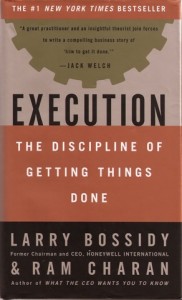The one-sentence summary
Concentrate on getting something done as much as having the original idea.
Can’t be bothered to read it? Listen to the 5-minute summary.
WHAT THE BOOK SAYS
- Subtitled The Discipline of Getting Things Done, it explains how leaders of big companies can get people to deliver what they say they will.
- It’s no good formulating a ‘vision’ and leaving others to get on with it – bosses need to be passionately and deeply engaged and having robust dialogue about people, strategy and operations.
- People mistakenly think of execution as the tactical side of the business, which seduces leaders into concentrating on the so-called bigger issues. This leads to a gap between the promises leaders make and the results the organisation delivers. In 2000, the CEOs of 40 of the top Fortune 200 companies were removed for that very reason.
- To understand execution, you need to understand:
Execution is a discipline, and integral to strategy
Execution is the major job of the business leader
Execution must be a core element of an agency’s culture
- It is also a systematic way of exposing reality and acting on it.
WHAT’S GOOD ABOUT IT
- Leaders need to engage in 7 essential behaviours to be good at execution:
1. Know your people and your business – leaders have to live their businesses
2. Insist on realism – honesty and a lack of fear in discussing issues is vital
3. Set clear goals and priorities – never set more than 3 or 4
4. Follow through – setting goals is no good if they don’t happen
5. Reward the doers – there must be a link between execution and reward
6. Expand people’s capabilities – see every encounter as an opportunity to coach
7. Know yourself – you need emotional fortitude and personal honesty
- A leader who says “I’ve got ten priorities” doesn’t know what he’s talking about.
- Leaders have to have emotional fortitude, which is made up of authenticity, self-awareness, self-mastery and humility.
- We don’t think our way into a new way of acting, we act our way into a new way of thinking.
- The social software of execution is the people. Meetings without robust debate means that people don’t state their misgivings, so nothing is enacted.
- Leaders get the behaviour they exhibit and tolerate.
- If a strategy does not address the hows, it is destined for failure.
- The crucial question is: can the business execute the strategy?
WHAT YOU HAVE TO WATCH
- Most of the examples are American, and the book came out in 2002.
